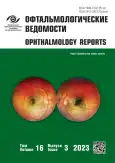Residual astigmatism calculation method in implantation of a monofocal non-toric intraocular lens
- Authors: Belov D.F.1,2, Nikolaenko V.P.1,2, Alekseeva A.G.2
-
Affiliations:
- Saint Petersburg Multifield Hospital No. 2
- Saint Petersburg State University
- Issue: Vol 16, No 3 (2023)
- Pages: 45-52
- Section: Original study articles
- URL: https://journals.rcsi.science/ov/article/view/148219
- DOI: https://doi.org/10.17816/OV321678
- ID: 148219
Cite item
Abstract
BACKGROUND: Nowadays, phacoemulsification with monofocal non-toric intraocular lens (IOL) implantation is a most common procedure in cataract surgery. Residual astigmatism has an important impact on uncorrected visual acuity. Therefore, development of residual astigmatism assessment method is relevant and may expand indications for toric IOL implantation.
AIM: To develop a method for calculating residual astigmatism in cases when non-toric monofocal IOL is implanted.
MATERIALS AND METHODS: The study included 351 patients (391 eyes, 105 men and 246 women, mean age 75.3 ± 8.5 years) who underwent phacoemulsification with non-toric monofocal IOL implantation. Biometry was performed by IOL-Master 500, postoperative refraction was assessed by autorefractometer Topcon-8800.
RESULTS: Using regression analysis, where the depended variable was residual astigmatism, and preoperative corneal astigmatism and steep corneal meridian axis location served as covariates, we revealed a significant relation (p < 0.001) with medium strength (R2 = 0.51) between these parameters, which formed residual astigmatism calculation formula for monofocal non-toric IOL implantation: Ast = KAst · 0.71 – 0.62 · sinKax + 0.73.
CONCLUSIONS: This formula may allow to evaluate the residual astigmatism and justify a decision on the advisability of toric IOL implantation.
Full Text
##article.viewOnOriginalSite##About the authors
Dmitrii F. Belov
Saint Petersburg Multifield Hospital No. 2; Saint Petersburg State University
Author for correspondence.
Email: belovd1990@gmail.com
ORCID iD: 0000-0003-0776-4065
SPIN-code: 2380-2273
MD, Cand. Sci. (Med.); Ophthalmologist; Assistant Performing Medical Work, Department of Otorhinolaryngology and Ophthalmology
Russian Federation, Saint Petersburg; Saint PetersburgVadim P. Nikolaenko
Saint Petersburg Multifield Hospital No. 2; Saint Petersburg State University
Email: dr.Nikolaenko@mail.ru
ORCID iD: 0000-0002-6393-1289
SPIN-code: 4906-2542
MD, Dr. Sci. (Med.), Deputy Head Doctor of Ophthalmological Center; Professor of the Department of Otorhinolaryngology and Ophthalmology
Russian Federation, Saint Petersburg; Saint PetersburgAngelina G. Alekseeva
Saint Petersburg State University
Email: angecoon@icloud.com
ORCID iD: 0009-0000-5852-4999
Student
Russian Federation, Saint PetersburgReferences
- Libman ES. Slepota i invalidnost’ vsledstvie patologii organa zreniya v Rossii. Natsional’noe rukovodstvo. Moscow: Oftal’mologiya, 2008. (In Russ.)
- Cataract surgical rates. Community Eye Health. 2017;30(100): 88–89.
- Belov DF, Nikolaenko VP. Alternative method of intraocular lens power calculation in eyes with short axial length. The Russian Annals of Ophthalmology. 2022;138(3):2428. (In Russ.) doi: 10.17116/oftalma202213803124
- Belov DF, Potemkin VV, Nikolaenko VP. Optimization of intraocular lens power calculation in pseudoexfoliation syndrome. The Russian Annals of Ophthalmology. 2021;137(4):38–42. (In Russ.) doi: 10.17116/oftalma202113704138
- Melles RB, Holladay JT, Chang WJ. Accuracy of intraocular lens calculation formulas. Ophthalmology. 2018;125(2):169–178. doi: 10.1016/j.ophtha.2017.08.027
- Kopaev SYu, Ilinskaya IA, Bessarabov AN. Corneal astigmatism in patients with various ophthalmic pathologies. The Russian Annals of Ophthalmology. 2021;137(2):59–65. (In Russ.) doi: 10.17116/oftalma202113702159
- Boiko EV, Shukhaev SV, Kudlakhmedov SS, Litvin IB. Comparative evaluation of surgical correction of corneal astigmatism by toric IOL implantation using various keratometric data and calculation methods. Fyodorov Journal of Ophthalmic Surgery. 2022;(4): 36–44. (In Russ.) doi: 10.25276/0235-4160-2022-4-36-44
- Rakhmanov VV, Khripun KV, Astakhov SY, Ramazanova AM. Approach to cataract surgery in patients with irregular astigmatism due to pronounced corneal pathology. Ophthalmology Reports. 2014;7(4):5–9. (In Russ.) doi: 10.17816/OV201445-9
- Srinivasan S. ESCRS Clinical trends survey 2017, Toric IOL decisions. Eyeworld Supplements. 2017;5–6.
- Can İ, Takmaz T, Özdamar A, et al. Evaluation of the cataract surgery 2018 survey in terms of achieving refractive cataract surgery targets. Turk J Ophthalmol. 2021;51(1):7–18. doi: 10.4274/tjo.galenos.2020.46020
- Simons RWP, Visser N, van den Biggelaar FJHM, et al. Trial-based cost-effectiveness analysis of toric versus monofocal intraocular lenses in cataract patients with bilateral corneal astigmatism in the Netherlands. J Cataract Refract Surg. 2019;45(2):146–152. doi: 10.1016/j.jcrs.2018.09.019
- De Bernardo M, Zeppa L, Cennamo M, et al. Prevalence of corneal astigmatism before cataract surgery in Caucasian patients. Eur J Ophthalmol. 2014;24(4):494–500. doi: 10.5301/ejo.5000415
- Yang S, Byun Y-S, Kim HS, Chung S-H. Comparative accuracy of Barrett toric calculator with and without posterior corneal astigmatism measurements and the Kane toric formula. Am J Ophthalmol. 2021;231:48–57. doi: 10.1016/j.ajo.2021.05.028
- Reitblat O, Barnir EM, Qassoom A, et al. Comparison of the Barrett toric calculator using measured and predicted posterior corneal astigmatism, the Kane and Abulafia–Koch calculators. J Cataract Refract Surg. 2023;49(7):704–710. doi: 10.1097/j.jcrs.0000000000001178
- Li H, Wang Y, Chen M, et al. Distribution of the anterior corneal astigmatism in over 140 000 patients with age-related cataract. Zhonghua Yan Ke Za Zhi. 2021;57(1):56–62. doi: 10.3760/cma.j.cn112142-20200107-00010
- Motamed-Gorji N, Jafari A, Mohammadi SF, et al. Associated factors and distribution of posterior corneal astigmatism in a middle-aged population. Clin Exp Optom. 2022;105(8):806–812. doi: 10.1080/08164622.2021.1992249
Supplementary files











